Getting ready for my next camping trip, I see how key packing is. The right stuff and a good plan mean more fun and less worry. I’ll share top tips to pack smart, so I’m ready for nature’s adventures.
Studies say packing well cuts down on stress and boosts the fun. REI and Outdoor Magazine agree, making it a must for a great trip.
Key Takeaways
- Efficient packing is crucial for enjoyable weekend camping trips.
- Organization and preparation reduce stress while camping.
- Planning ahead enhances the overall outdoor adventure experience.
- Utilizing camping tips can streamline the packing process.
- Research supports the benefits of well-planned packing techniques.
Understanding the Essentials of Camping Gear
Going on a camping trip means knowing what gear to bring. The right camping equipment makes your outdoor adventure better. It’s important to pack the essentials for a great time.
- Tents: A good tent keeps you dry and safe from the weather.
- Sleeping Bags: Pick a sleeping bag that keeps you warm and cozy at night.
- Cooking Supplies: Good cooking gear lets you make tasty meals outdoors.
- First-Aid Kits: A first-aid kit is key for fixing small injuries and staying safe.
Quality camping gear makes your trip more comfortable and safe. Brands like REI and Coleman have many options. Knowing what gear fits your needs is crucial for a great camping trip.
Choosing the right gear makes your outdoor adventure better. It lets you enjoy every moment of your camping trip.
| Essential Camping Item | Description | Recommended Brands |
|---|---|---|
| Tent | Provides shelter from the elements. | REI, MSR, Coleman |
| Sleeping Bag | Offers warmth during nights in the outdoors. | North Face, Kelty, Nemo |
| Cooking Equipment | Includes portable stoves and utensils for meal preparation. | Jetboil, Camp Chef, GSI Outdoors |
| First-Aid Kit | Essential for treating minor injuries. | SOS, Adventure Medical Kits, AMK |
How to Pack Efficiently for a Weekend Camping Trip
Packing right is key for a great weekend camping trip. The right gear makes all the difference. I choose my tent and sleeping gear based on size, weight, and weather resistance. Knowing the difference between a day pack and a weekend pack helps me pack better.
Choosing the Right Tent and Sleeping Gear
For a weekend camping trip, picking the right tent and sleeping gear is essential. The tent should be light and big enough for me. It also needs to keep me dry and warm.
For sleeping, I pick a bag that fits the weather and a pad for comfort and warmth.
Day Pack vs. A Weekend Pack: What’s the Difference?
Choosing between a day pack and a weekend pack is important for efficient packing. A day pack is for short trips, while a weekend pack is for longer ones. I consider weight, size, and how easy it is to get to what I need.
Knowing the difference helps me pack smart. I carry only what I need, without too much weight.
Clothing Tips for Outdoor Adventures
When you go outside, the right clothes are key. My tips help you layer and pick materials for comfort. Layering clothes is vital for weather and activity changes. The right fabrics keep you dry and comfy, which is crucial for camping.
Layers and Materials: Staying Comfortable
For outdoor fun, layering is key. Begin with a moisture-wicking base layer to keep sweat away. This keeps you comfy during exercise.
The middle layer should keep you warm. Fleece is great for this. Your outer layer should protect from wind and rain. Choose jackets that breathe but stay dry, like Gore-Tex.
Footwear Choices for Different Terrains
Good camping shoes are essential for comfort and safety. For rocky trails, sturdy boots with ankle support are a must. Merrell and Columbia offer great options for different terrains.
Lightweight shoes are good for flat paths but not for uneven ground. Think about where you’ll be and pick shoes that offer support and grip. The right shoes can make your camping trip better.
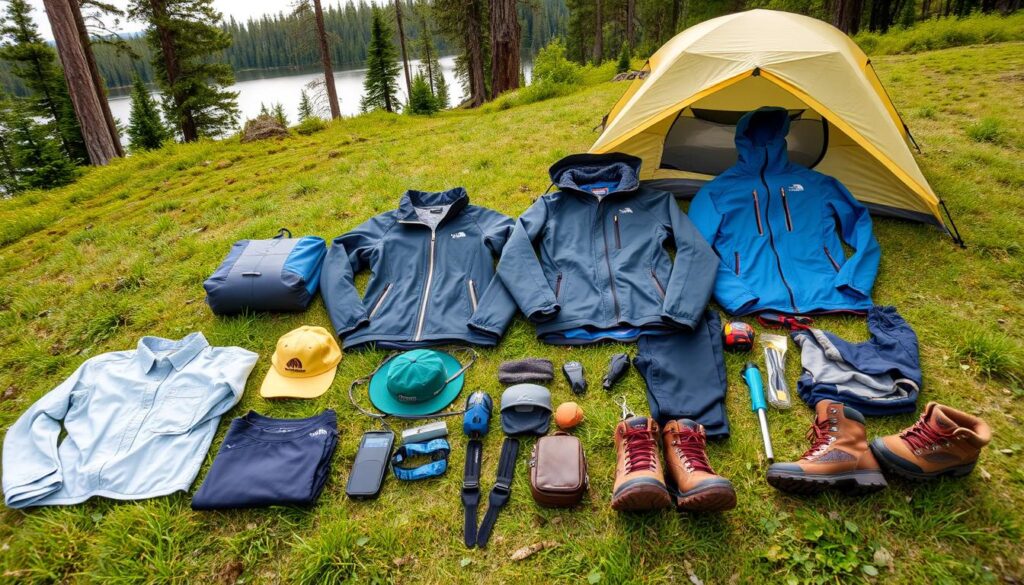
Food and Cooking Supplies: What to Bring
Planning meals for a camping trip is key. It involves choosing the right camping food supplies and cooking gear. Good meal planning means quick and easy meals. With the right stuff, I can enjoy tasty food outdoors.
Meal Planning for Efficiency
For camping meals, I aim for simple and healthy options. Here are some tips:
- Choose pre-packaged meals: Freeze-dried meals are nutritious and easy to prepare.
- Plan for leftovers: Cooking extra can save time for the next meal, making it easy.
- Opt for non-perishable items: Canned goods and dried pasta are great for camping, needing no fridge.
Portable Cooking Equipment: What Works Best
The right cooking gear makes a big difference in camping. Here are some top picks:
| Equipment | Benefits | Best For |
|---|---|---|
| Camping Stove | Easy to set up and use, provides consistent heat | Cooking a variety of meals |
| Portable Grill | Offers a great flavor for grilled items, often compact | Grilling meats and vegetables |
| French Press | Convenient way to make coffee or brew tea | Caffeinating in the morning |
| Camping Cookware Set | Nesting pots and pans reduce packing space | Cooking and boiling water |
With smart meal planning and the right gear, I can enjoy tasty meals outdoors. This lets me relax, explore, and enjoy nature more.
Efficient Use of Space: Packing Techniques
Packing smart for camping trips makes a big difference. It makes my trip more comfortable and organized. Using space-saving techniques like rolling and folding clothes helps a lot. Also, using compression bags for camping gear is great for bulky items like sleeping bags.
Rolling vs. Folding Clothing
Rolling clothes saves more space in my bags. It lets me fit more in a small area. But, folding clothes keeps things neat and prevents wrinkles, which is good for looking nice.
Choosing between rolling and folding depends on the clothes and space. Here’s a quick look at their differences:
| Method | Advantages | Disadvantages |
|---|---|---|
| Rolling Clothing |
|
|
| Folding Clothing |
|
|
Using Compression Bags for Sleeping Bags and Clothing
Compression bags are great for big items like sleeping bags. They make bulky items smaller, so I can pack more. This is especially useful when I need to fit everything in my pack without it being too big.
Using these bags makes packing easier and keeps my gear tidy at the campsite.
Organizing Your Gear for Easy Access
Organizing your camping gear makes outdoor adventures more fun and efficient. I’ve learned some great ways to keep your gear organized. This way, you can find what you need quickly.
Color-Coding and Labeling Containers
Color-coding your camping supplies is a smart move. Use different colors for cooking, sleeping, and personal items. This makes finding things fast and easy. Adding labels to containers helps even more, letting you know what’s inside right away.
Keep Frequently Used Items on Top
Keep your most-used items in easy spots. For me, that means having tools, utensils, and first-aid supplies ready to go. This saves time and lets you enjoy the outdoors more. It’s all about making your camping trips better.
Essential Camping Safety Items
Going on a camping trip? The right safety items are key. You’ll need first aid supplies and tools for navigation and lighting. These items help you stay safe and ready for anything.
First Aid Kit Essentials
A good first aid kit is a must-have. It should have:
- Adhesive bandages of varying sizes
- Antiseptic wipes for cleaning wounds
- Gauze pads and tape
- Antibiotic ointment
- Pain relievers
- Allergy medication
- A pair of scissors and tweezers
- A first aid manual or guide
These items can help with minor injuries. They make your camping trip safer.
Navigation and Lighting Tools
Knowing the wilderness is crucial. You’ll need:
- Topographic maps and a compass
- GPS device for accurate location tracking
- Local trail guides with important landmarks
For night safety, you’ll also need:
- A flashlight with extra batteries
- Headlamps for hands-free illumination
- Lanterns to light up the campsite
The Benefits of Making a Packing List
Creating a camping packing list is key to my camping prep. It’s simple but powerful, making my trip better. With a list, I avoid forgetting important items that make a trip comfy.
One big benefit of packing lists is how they organize things. Writing down what I need makes packing easier. It also helps me relax, knowing I won’t forget anything.
Studies show that using a packing list makes me better prepared. It leads to a more fun and successful camping trip. I think about the terrain, weather, and trip length when packing.
Here’s a quick overview of how a packing list can enhance my camping experience:
| Benefit | Description |
|---|---|
| Reduces Forgetfulness | Minimizes the chances of leaving essential items behind. |
| Increases Packing Efficiency | Streamlines the packing process, saving time and effort. |
| Boosts Confidence | Ensures that I feel prepared and ready for my camping adventure. |
| Encourages Thoughtful Preparation | Allows for better planning based on specific trip requirements. |
5 DIY Camping Projects to Improve Your Campsite
Turning your campsite into a cozy retreat can make your outdoor adventures better. By doing easy DIY projects, you can make your space your own and more useful. Here are five ways to make your camping spot more comfortable and practical.
Creating a Sitting Area with Pallets
Turning pallets into a seating area is a great way to make your campsite look and feel better. These wooden platforms can become benches or tables. Just stack and secure them to create a comfy spot to unwind.
To make it even cozier, add cushions or outdoor blankets. This will give your campsite a personal touch.
DIY Fire Pit Ideas
Building a fire pit is a fun DIY project that adds warmth and charm. Use rocks or bricks to make a circle that keeps your fire safe. It’s perfect for sharing stories and roasting marshmallows.
It also makes your campsite feel more welcoming. For more camping tips, check out this resource.
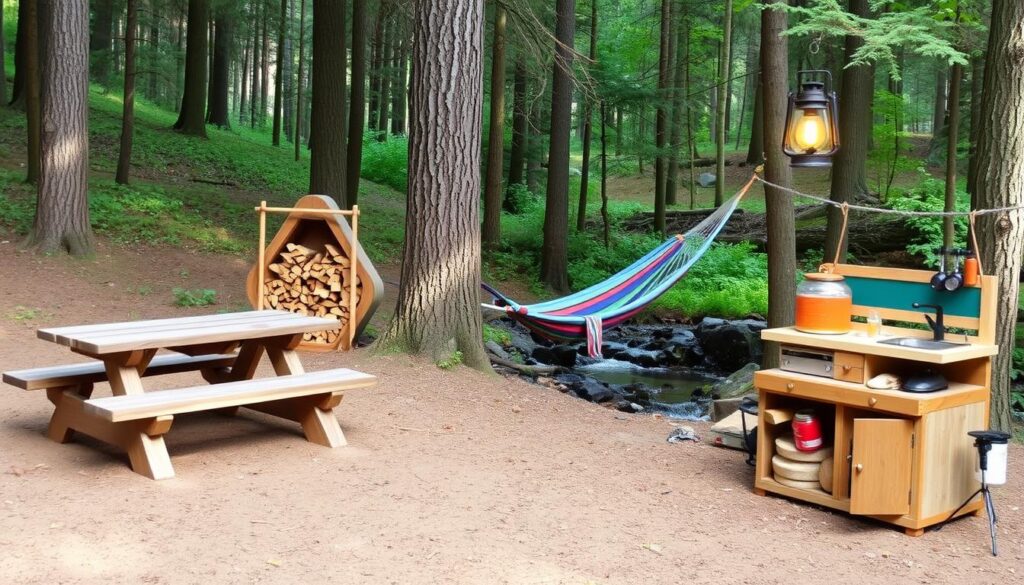
| Project | Materials Needed | Benefits |
|---|---|---|
| Creating a Sitting Area | Pallets, cushions | Comfortable seating, aesthetic appeal |
| DIY Fire Pit | Rocks or bricks, metal fire ring (optional) | Warmth, cooking, ambiance |
These DIY projects add creativity and lasting benefits to your camping trips. By improving your campsite, you can make your outdoor adventures more fun and memorable. For even more ideas, explore some great camping hacks to enhance your experience.
Camping Tips and Tricks for Newbies
Setting up camp and keeping gear organized can be tough for new campers. Learning quick setup and organization tips can make camping better. Here are some helpful ideas to make your camping trip smoother.
Setting Up Camp Quickly
Time is key when setting up camp. Here are some steps for a fast setup:
- Choose a flat, dry area: Find a spot without debris or big rocks.
- Layout your gear: Organize everything you need before unpacking.
- Practice tent assembly: Knowing how to set up your tent saves time.
- Set up the sleeping area first: Make your sleeping area comfortable first.
Staying Organized While Camping
Being organized makes camping more enjoyable. Here are some tips for staying organized:
- Color-code containers: Use different colors for cooking, personal items, and safety gear.
- Use a campsite checklist: A packing list ensures you don’t forget anything important.
- Keep frequently used items accessible: Arrange your items so essentials are easy to find.
- Secure food and waste: Store food in containers and manage waste to avoid animal problems.
Using these tips, I can enjoy the outdoors more. Quick setup and organization lead to a great camping experience without hassle.
How to Maximize Comfort While Camping
When I go camping, making sure I’m comfortable is key. The right furniture can make a big difference. Lightweight chairs and collapsible tables help create a cozy spot.
These items are easy to set up and move around. They let me enjoy meals or relax after a day of exploring without feeling uncomfortable.
Portable Furniture Options
Adding portable furniture to my camping gear makes the outdoors feel like home. A good folding chair can turn sitting on the ground into a comfortable experience. Portable tables are also great for cooking and socializing.
Using these items is one of the best tips for camping comfort I’ve found.
Insulating Your Sleeping Area
Keeping my sleeping area warm is also important. Cold ground can disrupt even the most excited camper’s sleep. I use a quality mat or sleeping pad for cushioning and insulation.
Layering my sleeping bag with extra blankets helps keep me warm at night. This ensures I wake up feeling refreshed and ready for the next day.
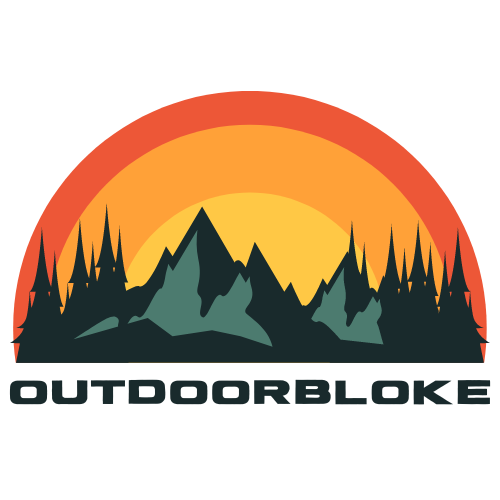


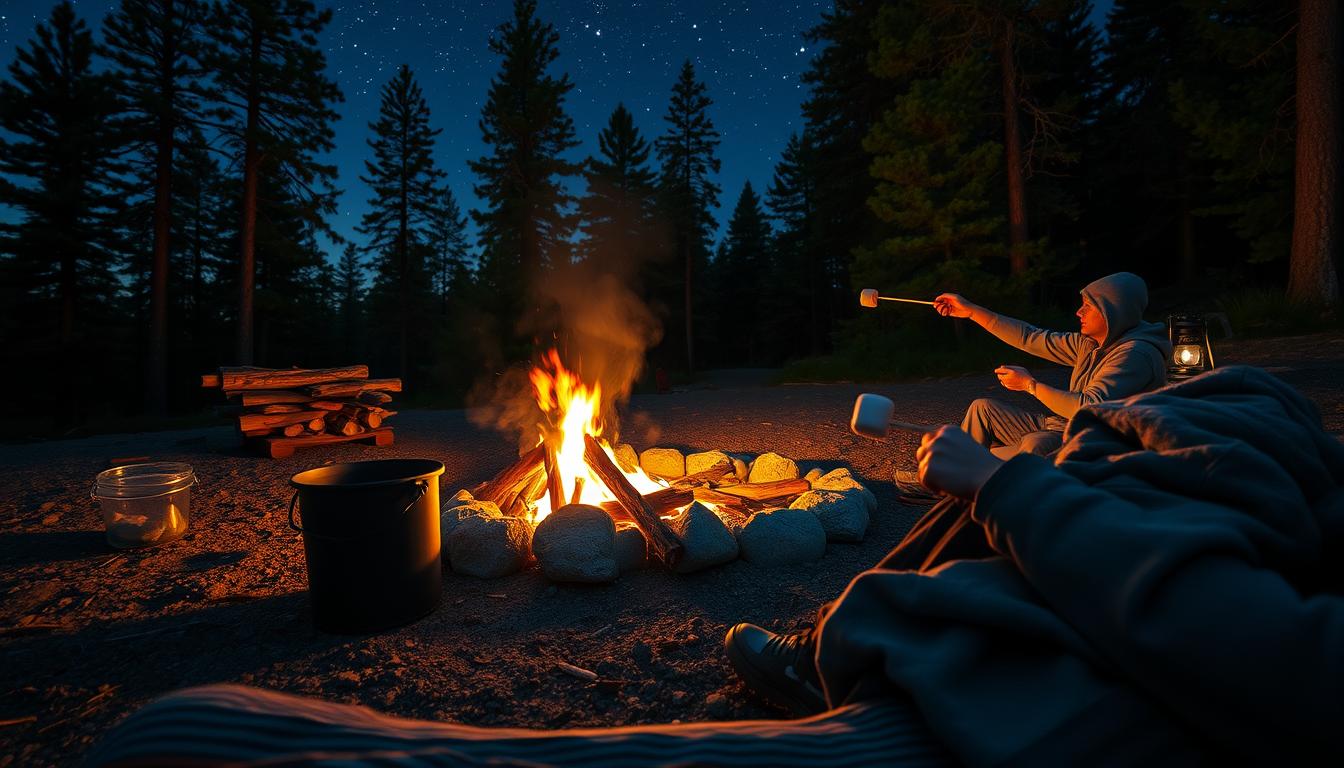
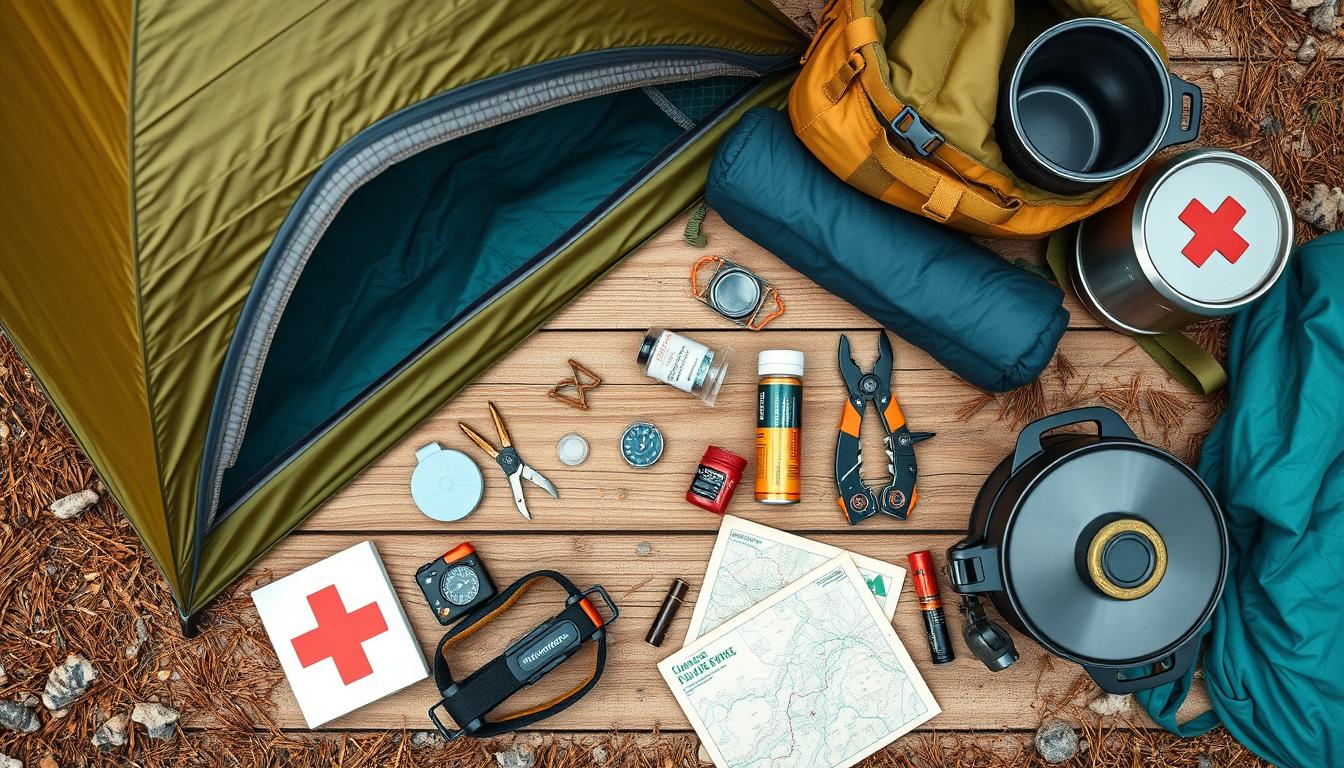
Leave a Reply